Analysis of Telstra's Business Environment: A Comprehensive Report
VerifiedAdded on 2021/12/29
|22
|7118
|32
Report
AI Summary
This report provides a detailed analysis of Telstra Corporation Limited's business environment. It begins with an introduction outlining the importance of environmental factors in strategic decision-making. The report then analyzes Telstra's operations, including its services, history, and key personnel, followed by an external environment analysis using PESTEL and Porter's Five Forces frameworks to identify key factors affecting the company. The analysis covers political, economic, social, technological, environmental, and legal factors, along with competitive forces, highlighting their impact on Telstra's profitability and market position. The report also examines the losses suffered by Telstra, pinpointing specific events that contributed to these losses based on the external analysis. Furthermore, the report explores potential growth opportunities for Telstra and concludes with strategic recommendations for the company's management, focusing on how Telstra can overcome future losses and sustain growth in the competitive telecommunications market. References are included to support the analysis.

Business Environment
Telstra Corporation Limited
Telstra Corporation Limited
Paraphrase This Document
Need a fresh take? Get an instant paraphrase of this document with our AI Paraphraser
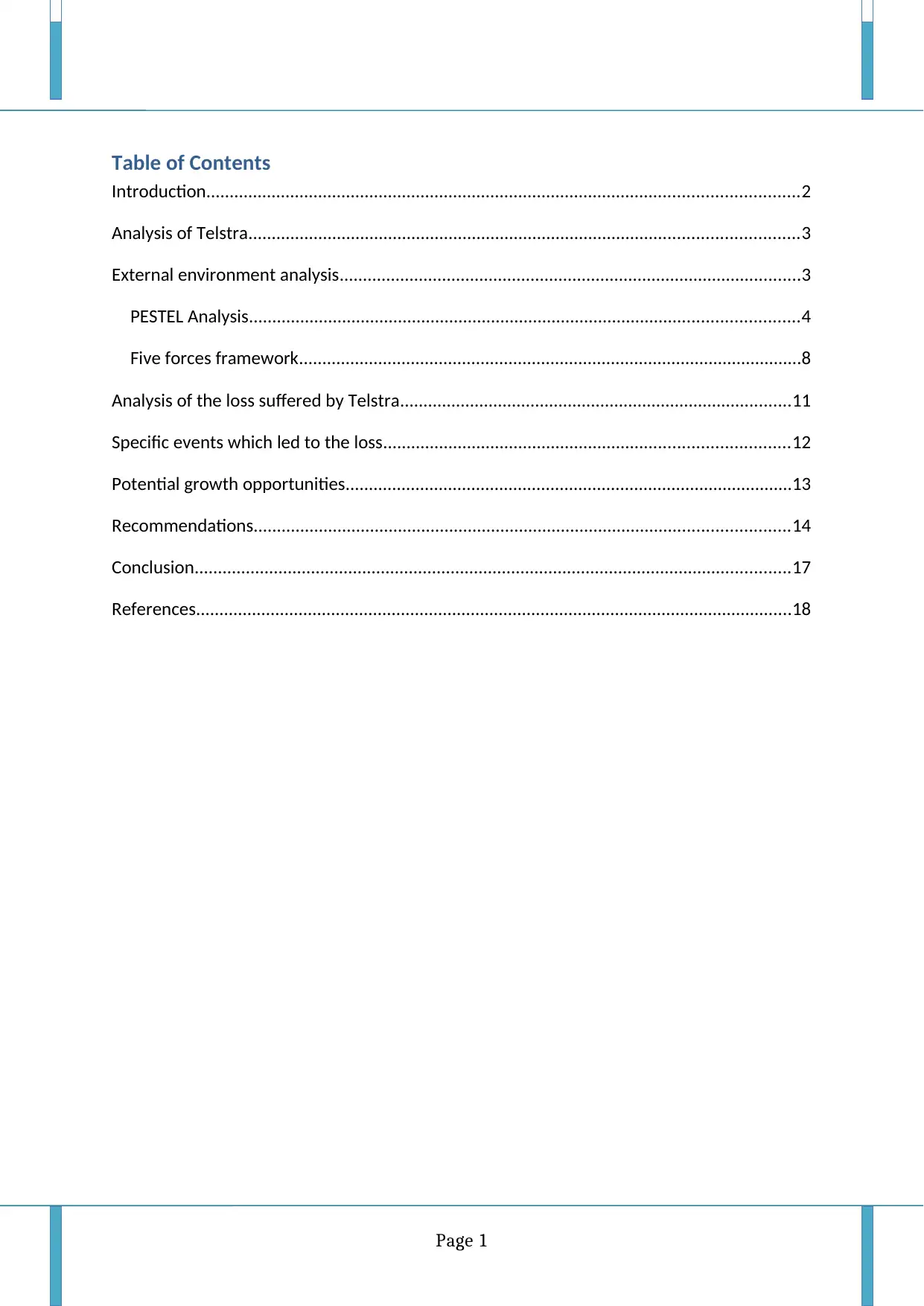
Table of Contents
Introduction...............................................................................................................................2
Analysis of Telstra......................................................................................................................3
External environment analysis...................................................................................................3
PESTEL Analysis......................................................................................................................4
Five forces framework............................................................................................................8
Analysis of the loss suffered by Telstra....................................................................................11
Specific events which led to the loss.......................................................................................12
Potential growth opportunities................................................................................................13
Recommendations...................................................................................................................14
Conclusion................................................................................................................................17
References................................................................................................................................18
Page 1
Introduction...............................................................................................................................2
Analysis of Telstra......................................................................................................................3
External environment analysis...................................................................................................3
PESTEL Analysis......................................................................................................................4
Five forces framework............................................................................................................8
Analysis of the loss suffered by Telstra....................................................................................11
Specific events which led to the loss.......................................................................................12
Potential growth opportunities................................................................................................13
Recommendations...................................................................................................................14
Conclusion................................................................................................................................17
References................................................................................................................................18
Page 1
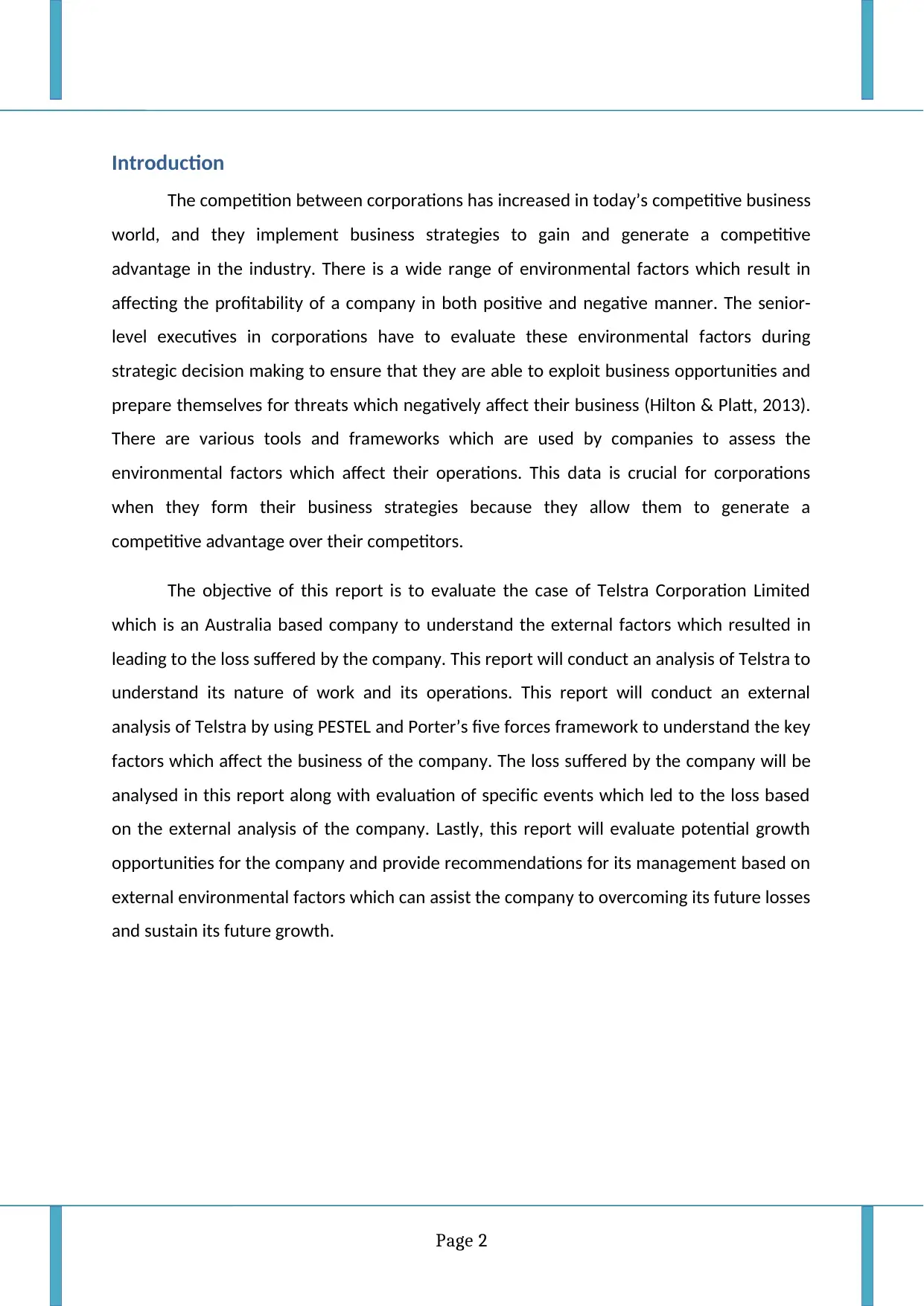
Introduction
The competition between corporations has increased in today’s competitive business
world, and they implement business strategies to gain and generate a competitive
advantage in the industry. There is a wide range of environmental factors which result in
affecting the profitability of a company in both positive and negative manner. The senior-
level executives in corporations have to evaluate these environmental factors during
strategic decision making to ensure that they are able to exploit business opportunities and
prepare themselves for threats which negatively affect their business (Hilton & Platt, 2013).
There are various tools and frameworks which are used by companies to assess the
environmental factors which affect their operations. This data is crucial for corporations
when they form their business strategies because they allow them to generate a
competitive advantage over their competitors.
The objective of this report is to evaluate the case of Telstra Corporation Limited
which is an Australia based company to understand the external factors which resulted in
leading to the loss suffered by the company. This report will conduct an analysis of Telstra to
understand its nature of work and its operations. This report will conduct an external
analysis of Telstra by using PESTEL and Porter’s five forces framework to understand the key
factors which affect the business of the company. The loss suffered by the company will be
analysed in this report along with evaluation of specific events which led to the loss based
on the external analysis of the company. Lastly, this report will evaluate potential growth
opportunities for the company and provide recommendations for its management based on
external environmental factors which can assist the company to overcoming its future losses
and sustain its future growth.
Page 2
The competition between corporations has increased in today’s competitive business
world, and they implement business strategies to gain and generate a competitive
advantage in the industry. There is a wide range of environmental factors which result in
affecting the profitability of a company in both positive and negative manner. The senior-
level executives in corporations have to evaluate these environmental factors during
strategic decision making to ensure that they are able to exploit business opportunities and
prepare themselves for threats which negatively affect their business (Hilton & Platt, 2013).
There are various tools and frameworks which are used by companies to assess the
environmental factors which affect their operations. This data is crucial for corporations
when they form their business strategies because they allow them to generate a
competitive advantage over their competitors.
The objective of this report is to evaluate the case of Telstra Corporation Limited
which is an Australia based company to understand the external factors which resulted in
leading to the loss suffered by the company. This report will conduct an analysis of Telstra to
understand its nature of work and its operations. This report will conduct an external
analysis of Telstra by using PESTEL and Porter’s five forces framework to understand the key
factors which affect the business of the company. The loss suffered by the company will be
analysed in this report along with evaluation of specific events which led to the loss based
on the external analysis of the company. Lastly, this report will evaluate potential growth
opportunities for the company and provide recommendations for its management based on
external environmental factors which can assist the company to overcoming its future losses
and sustain its future growth.
Page 2
⊘ This is a preview!⊘
Do you want full access?
Subscribe today to unlock all pages.

Trusted by 1+ million students worldwide
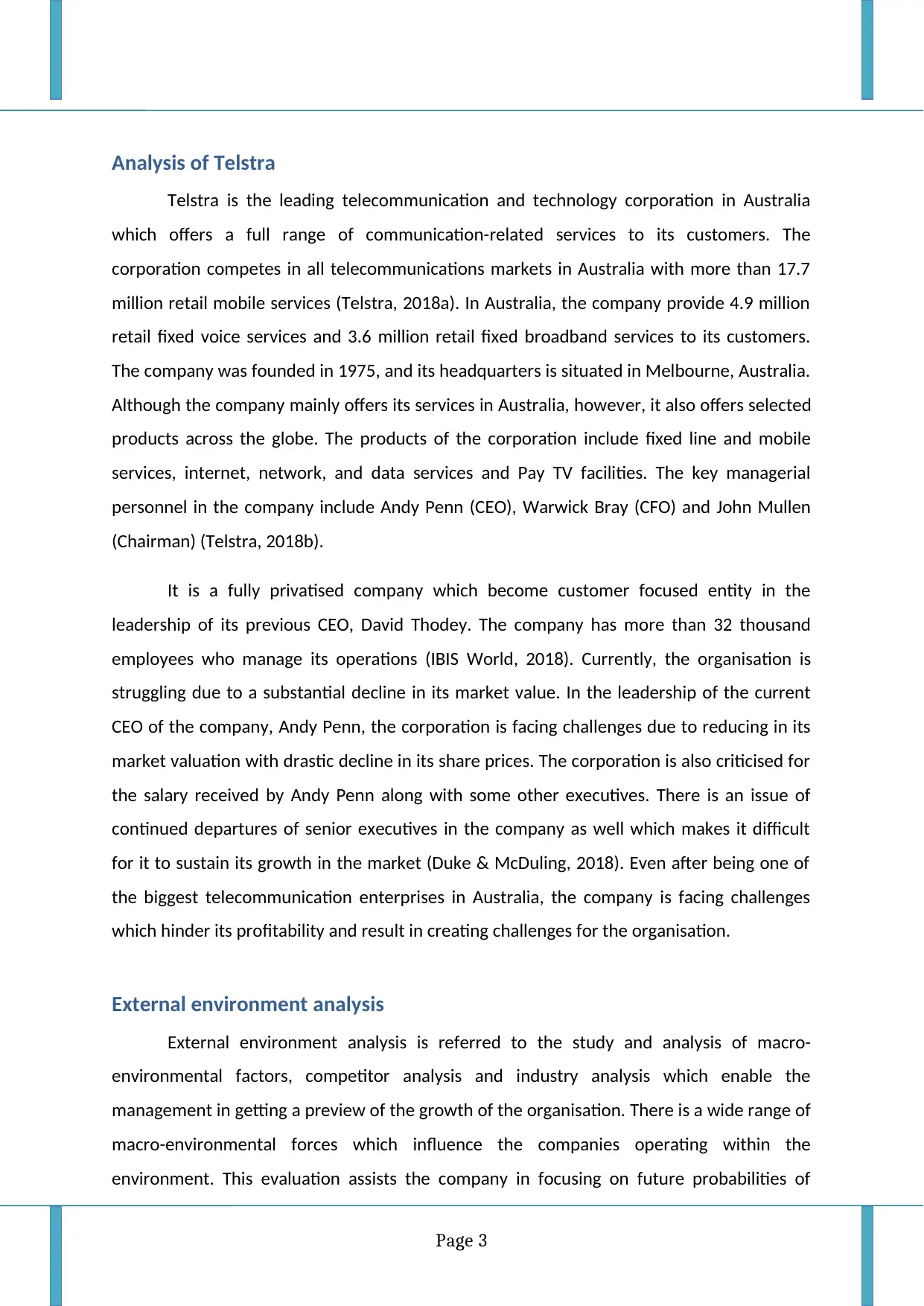
Analysis of Telstra
Telstra is the leading telecommunication and technology corporation in Australia
which offers a full range of communication-related services to its customers. The
corporation competes in all telecommunications markets in Australia with more than 17.7
million retail mobile services (Telstra, 2018a). In Australia, the company provide 4.9 million
retail fixed voice services and 3.6 million retail fixed broadband services to its customers.
The company was founded in 1975, and its headquarters is situated in Melbourne, Australia.
Although the company mainly offers its services in Australia, however, it also offers selected
products across the globe. The products of the corporation include fixed line and mobile
services, internet, network, and data services and Pay TV facilities. The key managerial
personnel in the company include Andy Penn (CEO), Warwick Bray (CFO) and John Mullen
(Chairman) (Telstra, 2018b).
It is a fully privatised company which become customer focused entity in the
leadership of its previous CEO, David Thodey. The company has more than 32 thousand
employees who manage its operations (IBIS World, 2018). Currently, the organisation is
struggling due to a substantial decline in its market value. In the leadership of the current
CEO of the company, Andy Penn, the corporation is facing challenges due to reducing in its
market valuation with drastic decline in its share prices. The corporation is also criticised for
the salary received by Andy Penn along with some other executives. There is an issue of
continued departures of senior executives in the company as well which makes it difficult
for it to sustain its growth in the market (Duke & McDuling, 2018). Even after being one of
the biggest telecommunication enterprises in Australia, the company is facing challenges
which hinder its profitability and result in creating challenges for the organisation.
External environment analysis
External environment analysis is referred to the study and analysis of macro-
environmental factors, competitor analysis and industry analysis which enable the
management in getting a preview of the growth of the organisation. There is a wide range of
macro-environmental forces which influence the companies operating within the
environment. This evaluation assists the company in focusing on future probabilities of
Page 3
Telstra is the leading telecommunication and technology corporation in Australia
which offers a full range of communication-related services to its customers. The
corporation competes in all telecommunications markets in Australia with more than 17.7
million retail mobile services (Telstra, 2018a). In Australia, the company provide 4.9 million
retail fixed voice services and 3.6 million retail fixed broadband services to its customers.
The company was founded in 1975, and its headquarters is situated in Melbourne, Australia.
Although the company mainly offers its services in Australia, however, it also offers selected
products across the globe. The products of the corporation include fixed line and mobile
services, internet, network, and data services and Pay TV facilities. The key managerial
personnel in the company include Andy Penn (CEO), Warwick Bray (CFO) and John Mullen
(Chairman) (Telstra, 2018b).
It is a fully privatised company which become customer focused entity in the
leadership of its previous CEO, David Thodey. The company has more than 32 thousand
employees who manage its operations (IBIS World, 2018). Currently, the organisation is
struggling due to a substantial decline in its market value. In the leadership of the current
CEO of the company, Andy Penn, the corporation is facing challenges due to reducing in its
market valuation with drastic decline in its share prices. The corporation is also criticised for
the salary received by Andy Penn along with some other executives. There is an issue of
continued departures of senior executives in the company as well which makes it difficult
for it to sustain its growth in the market (Duke & McDuling, 2018). Even after being one of
the biggest telecommunication enterprises in Australia, the company is facing challenges
which hinder its profitability and result in creating challenges for the organisation.
External environment analysis
External environment analysis is referred to the study and analysis of macro-
environmental factors, competitor analysis and industry analysis which enable the
management in getting a preview of the growth of the organisation. There is a wide range of
macro-environmental forces which influence the companies operating within the
environment. This evaluation assists the company in focusing on future probabilities of
Page 3
Paraphrase This Document
Need a fresh take? Get an instant paraphrase of this document with our AI Paraphraser
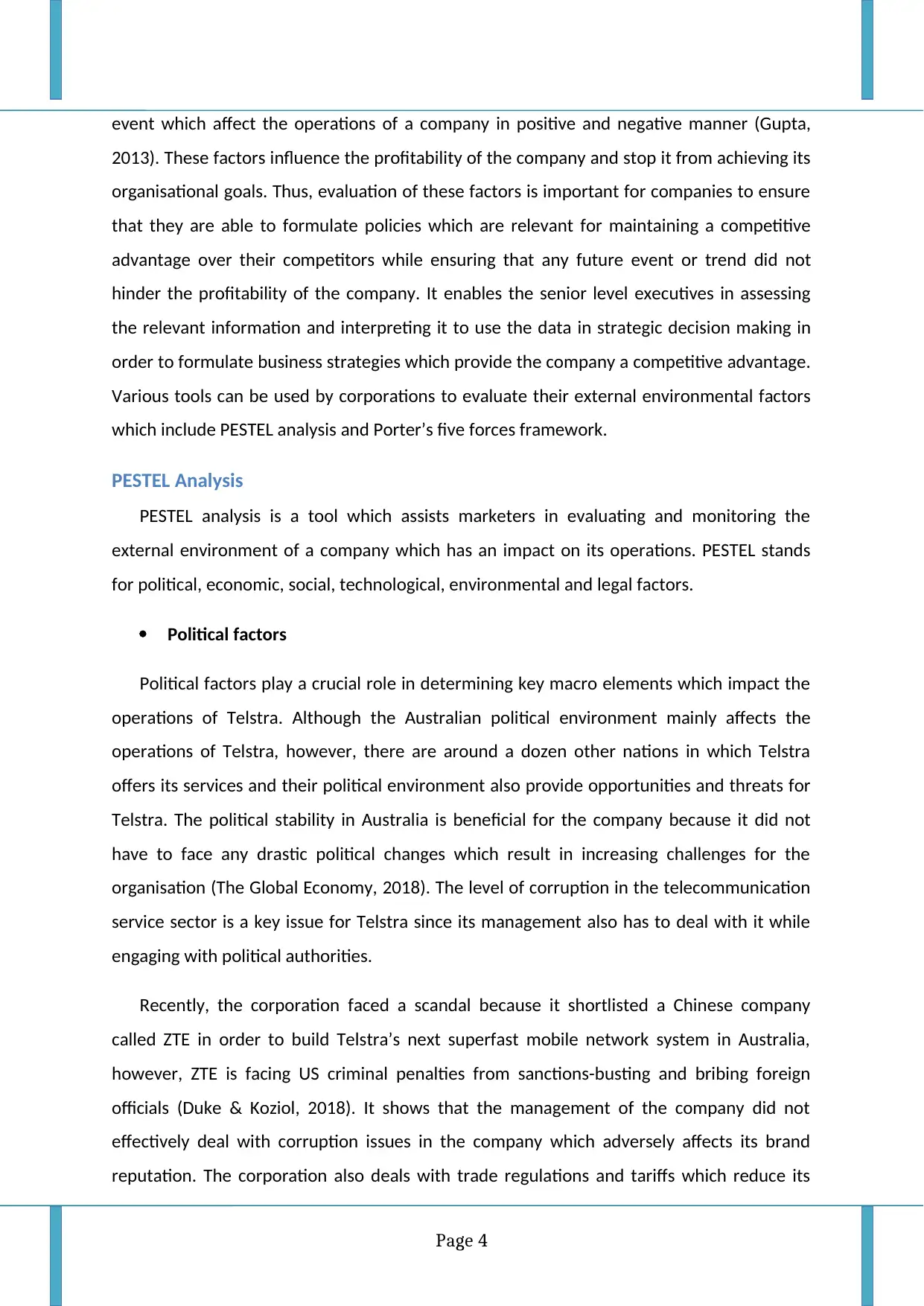
event which affect the operations of a company in positive and negative manner (Gupta,
2013). These factors influence the profitability of the company and stop it from achieving its
organisational goals. Thus, evaluation of these factors is important for companies to ensure
that they are able to formulate policies which are relevant for maintaining a competitive
advantage over their competitors while ensuring that any future event or trend did not
hinder the profitability of the company. It enables the senior level executives in assessing
the relevant information and interpreting it to use the data in strategic decision making in
order to formulate business strategies which provide the company a competitive advantage.
Various tools can be used by corporations to evaluate their external environmental factors
which include PESTEL analysis and Porter’s five forces framework.
PESTEL Analysis
PESTEL analysis is a tool which assists marketers in evaluating and monitoring the
external environment of a company which has an impact on its operations. PESTEL stands
for political, economic, social, technological, environmental and legal factors.
Political factors
Political factors play a crucial role in determining key macro elements which impact the
operations of Telstra. Although the Australian political environment mainly affects the
operations of Telstra, however, there are around a dozen other nations in which Telstra
offers its services and their political environment also provide opportunities and threats for
Telstra. The political stability in Australia is beneficial for the company because it did not
have to face any drastic political changes which result in increasing challenges for the
organisation (The Global Economy, 2018). The level of corruption in the telecommunication
service sector is a key issue for Telstra since its management also has to deal with it while
engaging with political authorities.
Recently, the corporation faced a scandal because it shortlisted a Chinese company
called ZTE in order to build Telstra’s next superfast mobile network system in Australia,
however, ZTE is facing US criminal penalties from sanctions-busting and bribing foreign
officials (Duke & Koziol, 2018). It shows that the management of the company did not
effectively deal with corruption issues in the company which adversely affects its brand
reputation. The corporation also deals with trade regulations and tariffs which reduce its
Page 4
2013). These factors influence the profitability of the company and stop it from achieving its
organisational goals. Thus, evaluation of these factors is important for companies to ensure
that they are able to formulate policies which are relevant for maintaining a competitive
advantage over their competitors while ensuring that any future event or trend did not
hinder the profitability of the company. It enables the senior level executives in assessing
the relevant information and interpreting it to use the data in strategic decision making in
order to formulate business strategies which provide the company a competitive advantage.
Various tools can be used by corporations to evaluate their external environmental factors
which include PESTEL analysis and Porter’s five forces framework.
PESTEL Analysis
PESTEL analysis is a tool which assists marketers in evaluating and monitoring the
external environment of a company which has an impact on its operations. PESTEL stands
for political, economic, social, technological, environmental and legal factors.
Political factors
Political factors play a crucial role in determining key macro elements which impact the
operations of Telstra. Although the Australian political environment mainly affects the
operations of Telstra, however, there are around a dozen other nations in which Telstra
offers its services and their political environment also provide opportunities and threats for
Telstra. The political stability in Australia is beneficial for the company because it did not
have to face any drastic political changes which result in increasing challenges for the
organisation (The Global Economy, 2018). The level of corruption in the telecommunication
service sector is a key issue for Telstra since its management also has to deal with it while
engaging with political authorities.
Recently, the corporation faced a scandal because it shortlisted a Chinese company
called ZTE in order to build Telstra’s next superfast mobile network system in Australia,
however, ZTE is facing US criminal penalties from sanctions-busting and bribing foreign
officials (Duke & Koziol, 2018). It shows that the management of the company did not
effectively deal with corruption issues in the company which adversely affects its brand
reputation. The corporation also deals with trade regulations and tariffs which reduce its
Page 4
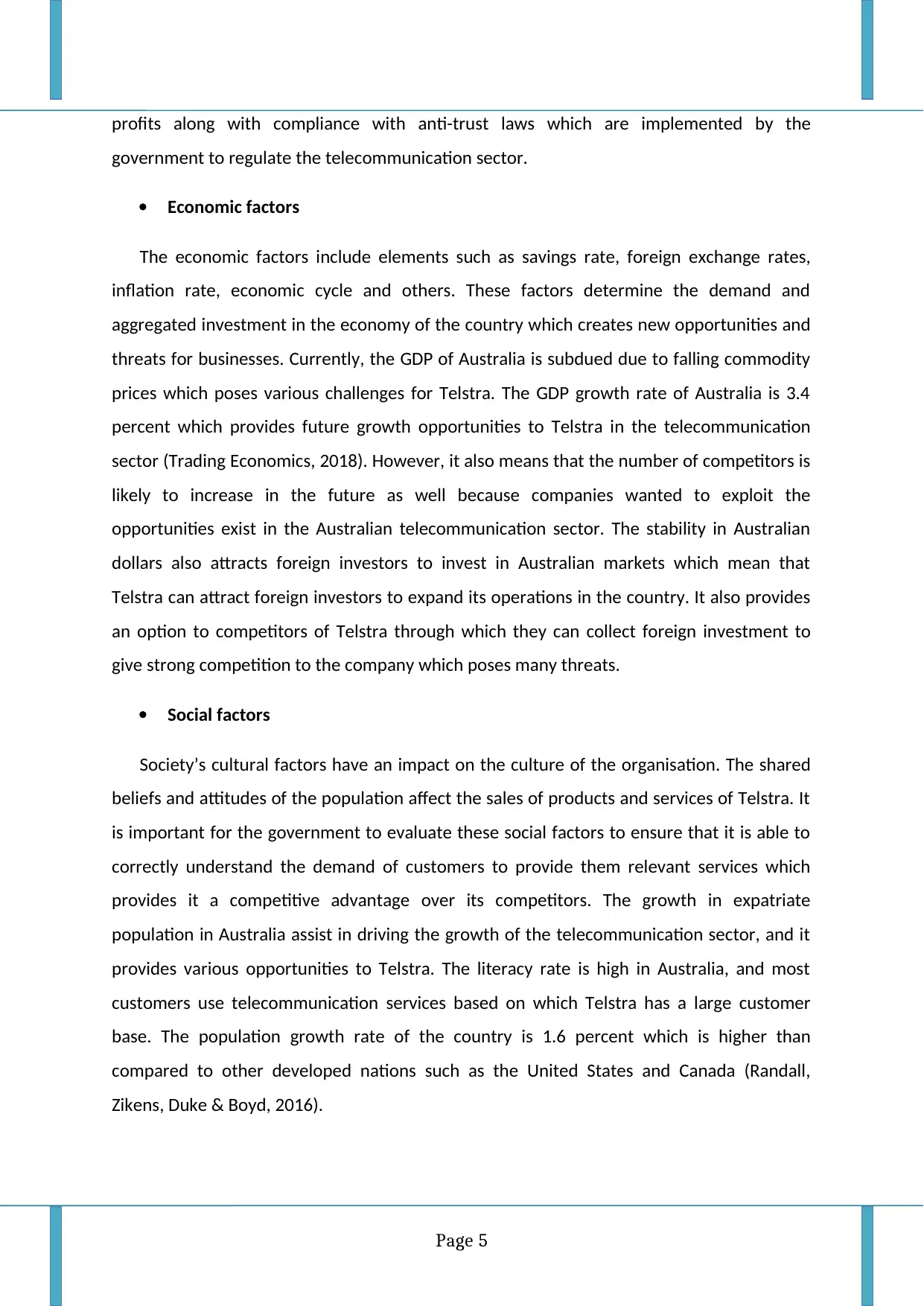
profits along with compliance with anti-trust laws which are implemented by the
government to regulate the telecommunication sector.
Economic factors
The economic factors include elements such as savings rate, foreign exchange rates,
inflation rate, economic cycle and others. These factors determine the demand and
aggregated investment in the economy of the country which creates new opportunities and
threats for businesses. Currently, the GDP of Australia is subdued due to falling commodity
prices which poses various challenges for Telstra. The GDP growth rate of Australia is 3.4
percent which provides future growth opportunities to Telstra in the telecommunication
sector (Trading Economics, 2018). However, it also means that the number of competitors is
likely to increase in the future as well because companies wanted to exploit the
opportunities exist in the Australian telecommunication sector. The stability in Australian
dollars also attracts foreign investors to invest in Australian markets which mean that
Telstra can attract foreign investors to expand its operations in the country. It also provides
an option to competitors of Telstra through which they can collect foreign investment to
give strong competition to the company which poses many threats.
Social factors
Society’s cultural factors have an impact on the culture of the organisation. The shared
beliefs and attitudes of the population affect the sales of products and services of Telstra. It
is important for the government to evaluate these social factors to ensure that it is able to
correctly understand the demand of customers to provide them relevant services which
provides it a competitive advantage over its competitors. The growth in expatriate
population in Australia assist in driving the growth of the telecommunication sector, and it
provides various opportunities to Telstra. The literacy rate is high in Australia, and most
customers use telecommunication services based on which Telstra has a large customer
base. The population growth rate of the country is 1.6 percent which is higher than
compared to other developed nations such as the United States and Canada (Randall,
Zikens, Duke & Boyd, 2016).
Page 5
government to regulate the telecommunication sector.
Economic factors
The economic factors include elements such as savings rate, foreign exchange rates,
inflation rate, economic cycle and others. These factors determine the demand and
aggregated investment in the economy of the country which creates new opportunities and
threats for businesses. Currently, the GDP of Australia is subdued due to falling commodity
prices which poses various challenges for Telstra. The GDP growth rate of Australia is 3.4
percent which provides future growth opportunities to Telstra in the telecommunication
sector (Trading Economics, 2018). However, it also means that the number of competitors is
likely to increase in the future as well because companies wanted to exploit the
opportunities exist in the Australian telecommunication sector. The stability in Australian
dollars also attracts foreign investors to invest in Australian markets which mean that
Telstra can attract foreign investors to expand its operations in the country. It also provides
an option to competitors of Telstra through which they can collect foreign investment to
give strong competition to the company which poses many threats.
Social factors
Society’s cultural factors have an impact on the culture of the organisation. The shared
beliefs and attitudes of the population affect the sales of products and services of Telstra. It
is important for the government to evaluate these social factors to ensure that it is able to
correctly understand the demand of customers to provide them relevant services which
provides it a competitive advantage over its competitors. The growth in expatriate
population in Australia assist in driving the growth of the telecommunication sector, and it
provides various opportunities to Telstra. The literacy rate is high in Australia, and most
customers use telecommunication services based on which Telstra has a large customer
base. The population growth rate of the country is 1.6 percent which is higher than
compared to other developed nations such as the United States and Canada (Randall,
Zikens, Duke & Boyd, 2016).
Page 5
⊘ This is a preview!⊘
Do you want full access?
Subscribe today to unlock all pages.

Trusted by 1+ million students worldwide
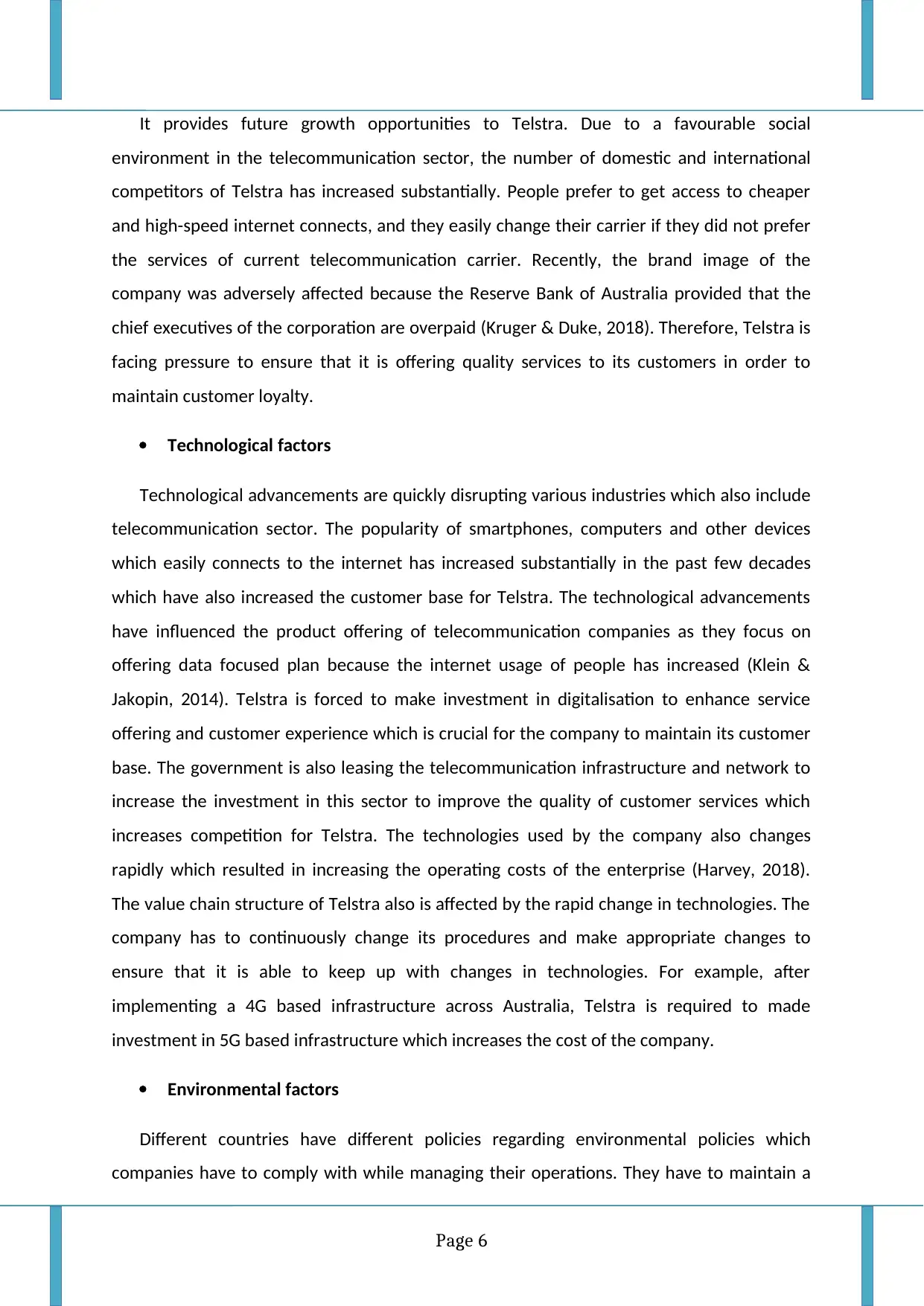
It provides future growth opportunities to Telstra. Due to a favourable social
environment in the telecommunication sector, the number of domestic and international
competitors of Telstra has increased substantially. People prefer to get access to cheaper
and high-speed internet connects, and they easily change their carrier if they did not prefer
the services of current telecommunication carrier. Recently, the brand image of the
company was adversely affected because the Reserve Bank of Australia provided that the
chief executives of the corporation are overpaid (Kruger & Duke, 2018). Therefore, Telstra is
facing pressure to ensure that it is offering quality services to its customers in order to
maintain customer loyalty.
Technological factors
Technological advancements are quickly disrupting various industries which also include
telecommunication sector. The popularity of smartphones, computers and other devices
which easily connects to the internet has increased substantially in the past few decades
which have also increased the customer base for Telstra. The technological advancements
have influenced the product offering of telecommunication companies as they focus on
offering data focused plan because the internet usage of people has increased (Klein &
Jakopin, 2014). Telstra is forced to make investment in digitalisation to enhance service
offering and customer experience which is crucial for the company to maintain its customer
base. The government is also leasing the telecommunication infrastructure and network to
increase the investment in this sector to improve the quality of customer services which
increases competition for Telstra. The technologies used by the company also changes
rapidly which resulted in increasing the operating costs of the enterprise (Harvey, 2018).
The value chain structure of Telstra also is affected by the rapid change in technologies. The
company has to continuously change its procedures and make appropriate changes to
ensure that it is able to keep up with changes in technologies. For example, after
implementing a 4G based infrastructure across Australia, Telstra is required to made
investment in 5G based infrastructure which increases the cost of the company.
Environmental factors
Different countries have different policies regarding environmental policies which
companies have to comply with while managing their operations. They have to maintain a
Page 6
environment in the telecommunication sector, the number of domestic and international
competitors of Telstra has increased substantially. People prefer to get access to cheaper
and high-speed internet connects, and they easily change their carrier if they did not prefer
the services of current telecommunication carrier. Recently, the brand image of the
company was adversely affected because the Reserve Bank of Australia provided that the
chief executives of the corporation are overpaid (Kruger & Duke, 2018). Therefore, Telstra is
facing pressure to ensure that it is offering quality services to its customers in order to
maintain customer loyalty.
Technological factors
Technological advancements are quickly disrupting various industries which also include
telecommunication sector. The popularity of smartphones, computers and other devices
which easily connects to the internet has increased substantially in the past few decades
which have also increased the customer base for Telstra. The technological advancements
have influenced the product offering of telecommunication companies as they focus on
offering data focused plan because the internet usage of people has increased (Klein &
Jakopin, 2014). Telstra is forced to make investment in digitalisation to enhance service
offering and customer experience which is crucial for the company to maintain its customer
base. The government is also leasing the telecommunication infrastructure and network to
increase the investment in this sector to improve the quality of customer services which
increases competition for Telstra. The technologies used by the company also changes
rapidly which resulted in increasing the operating costs of the enterprise (Harvey, 2018).
The value chain structure of Telstra also is affected by the rapid change in technologies. The
company has to continuously change its procedures and make appropriate changes to
ensure that it is able to keep up with changes in technologies. For example, after
implementing a 4G based infrastructure across Australia, Telstra is required to made
investment in 5G based infrastructure which increases the cost of the company.
Environmental factors
Different countries have different policies regarding environmental policies which
companies have to comply with while managing their operations. They have to maintain a
Page 6
Paraphrase This Document
Need a fresh take? Get an instant paraphrase of this document with our AI Paraphraser
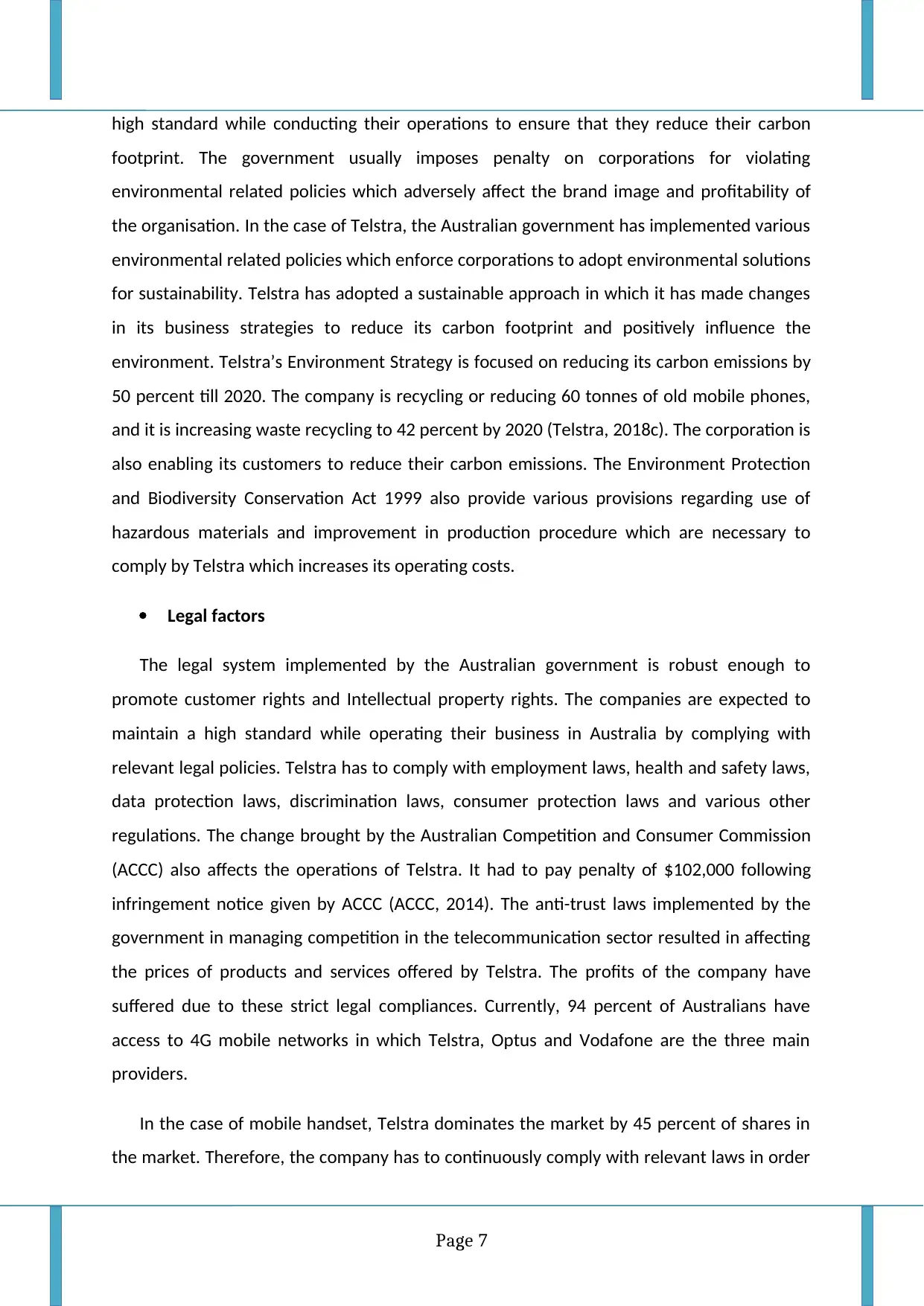
high standard while conducting their operations to ensure that they reduce their carbon
footprint. The government usually imposes penalty on corporations for violating
environmental related policies which adversely affect the brand image and profitability of
the organisation. In the case of Telstra, the Australian government has implemented various
environmental related policies which enforce corporations to adopt environmental solutions
for sustainability. Telstra has adopted a sustainable approach in which it has made changes
in its business strategies to reduce its carbon footprint and positively influence the
environment. Telstra’s Environment Strategy is focused on reducing its carbon emissions by
50 percent till 2020. The company is recycling or reducing 60 tonnes of old mobile phones,
and it is increasing waste recycling to 42 percent by 2020 (Telstra, 2018c). The corporation is
also enabling its customers to reduce their carbon emissions. The Environment Protection
and Biodiversity Conservation Act 1999 also provide various provisions regarding use of
hazardous materials and improvement in production procedure which are necessary to
comply by Telstra which increases its operating costs.
Legal factors
The legal system implemented by the Australian government is robust enough to
promote customer rights and Intellectual property rights. The companies are expected to
maintain a high standard while operating their business in Australia by complying with
relevant legal policies. Telstra has to comply with employment laws, health and safety laws,
data protection laws, discrimination laws, consumer protection laws and various other
regulations. The change brought by the Australian Competition and Consumer Commission
(ACCC) also affects the operations of Telstra. It had to pay penalty of $102,000 following
infringement notice given by ACCC (ACCC, 2014). The anti-trust laws implemented by the
government in managing competition in the telecommunication sector resulted in affecting
the prices of products and services offered by Telstra. The profits of the company have
suffered due to these strict legal compliances. Currently, 94 percent of Australians have
access to 4G mobile networks in which Telstra, Optus and Vodafone are the three main
providers.
In the case of mobile handset, Telstra dominates the market by 45 percent of shares in
the market. Therefore, the company has to continuously comply with relevant laws in order
Page 7
footprint. The government usually imposes penalty on corporations for violating
environmental related policies which adversely affect the brand image and profitability of
the organisation. In the case of Telstra, the Australian government has implemented various
environmental related policies which enforce corporations to adopt environmental solutions
for sustainability. Telstra has adopted a sustainable approach in which it has made changes
in its business strategies to reduce its carbon footprint and positively influence the
environment. Telstra’s Environment Strategy is focused on reducing its carbon emissions by
50 percent till 2020. The company is recycling or reducing 60 tonnes of old mobile phones,
and it is increasing waste recycling to 42 percent by 2020 (Telstra, 2018c). The corporation is
also enabling its customers to reduce their carbon emissions. The Environment Protection
and Biodiversity Conservation Act 1999 also provide various provisions regarding use of
hazardous materials and improvement in production procedure which are necessary to
comply by Telstra which increases its operating costs.
Legal factors
The legal system implemented by the Australian government is robust enough to
promote customer rights and Intellectual property rights. The companies are expected to
maintain a high standard while operating their business in Australia by complying with
relevant legal policies. Telstra has to comply with employment laws, health and safety laws,
data protection laws, discrimination laws, consumer protection laws and various other
regulations. The change brought by the Australian Competition and Consumer Commission
(ACCC) also affects the operations of Telstra. It had to pay penalty of $102,000 following
infringement notice given by ACCC (ACCC, 2014). The anti-trust laws implemented by the
government in managing competition in the telecommunication sector resulted in affecting
the prices of products and services offered by Telstra. The profits of the company have
suffered due to these strict legal compliances. Currently, 94 percent of Australians have
access to 4G mobile networks in which Telstra, Optus and Vodafone are the three main
providers.
In the case of mobile handset, Telstra dominates the market by 45 percent of shares in
the market. Therefore, the company has to continuously comply with relevant laws in order
Page 7
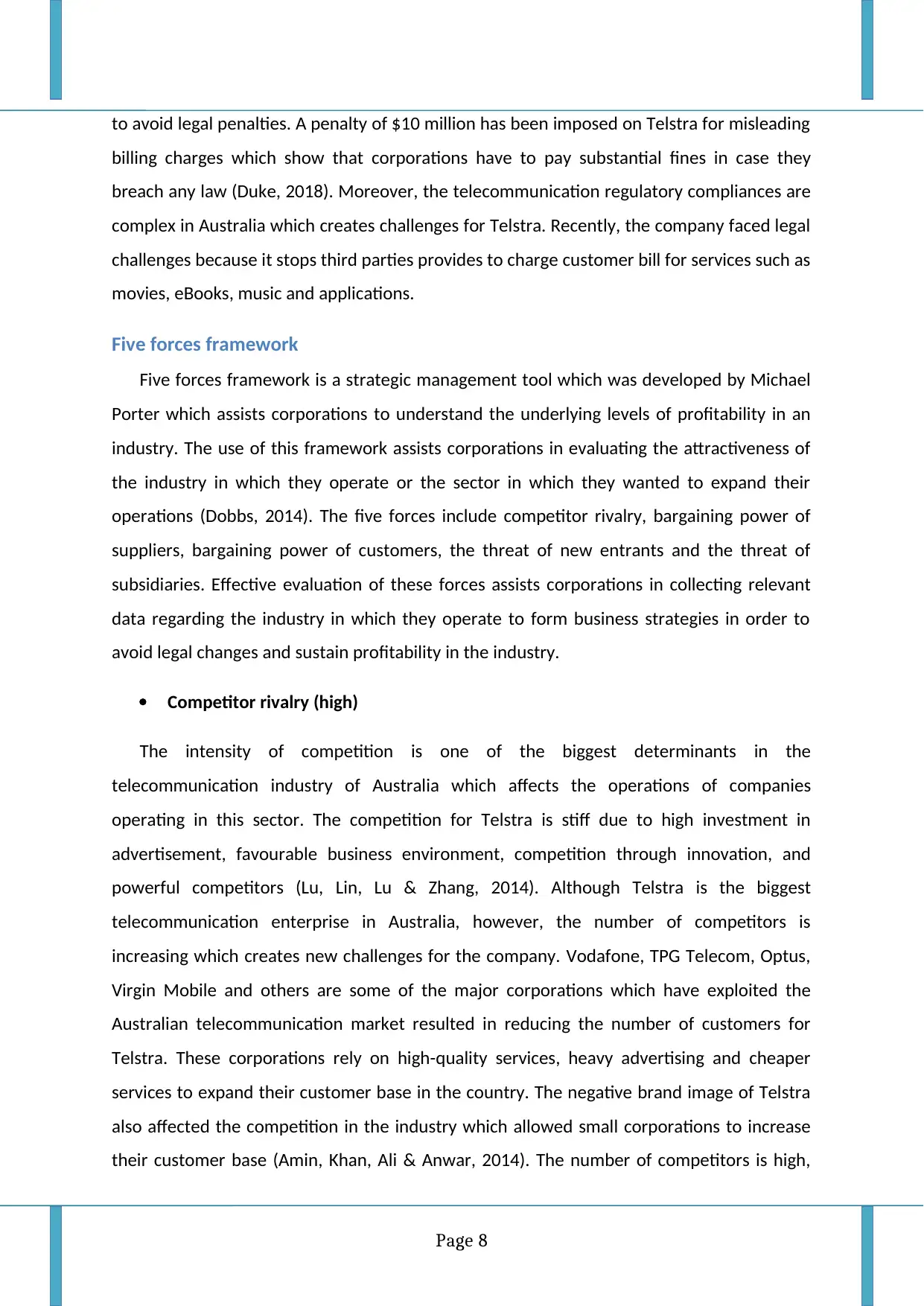
to avoid legal penalties. A penalty of $10 million has been imposed on Telstra for misleading
billing charges which show that corporations have to pay substantial fines in case they
breach any law (Duke, 2018). Moreover, the telecommunication regulatory compliances are
complex in Australia which creates challenges for Telstra. Recently, the company faced legal
challenges because it stops third parties provides to charge customer bill for services such as
movies, eBooks, music and applications.
Five forces framework
Five forces framework is a strategic management tool which was developed by Michael
Porter which assists corporations to understand the underlying levels of profitability in an
industry. The use of this framework assists corporations in evaluating the attractiveness of
the industry in which they operate or the sector in which they wanted to expand their
operations (Dobbs, 2014). The five forces include competitor rivalry, bargaining power of
suppliers, bargaining power of customers, the threat of new entrants and the threat of
subsidiaries. Effective evaluation of these forces assists corporations in collecting relevant
data regarding the industry in which they operate to form business strategies in order to
avoid legal changes and sustain profitability in the industry.
Competitor rivalry (high)
The intensity of competition is one of the biggest determinants in the
telecommunication industry of Australia which affects the operations of companies
operating in this sector. The competition for Telstra is stiff due to high investment in
advertisement, favourable business environment, competition through innovation, and
powerful competitors (Lu, Lin, Lu & Zhang, 2014). Although Telstra is the biggest
telecommunication enterprise in Australia, however, the number of competitors is
increasing which creates new challenges for the company. Vodafone, TPG Telecom, Optus,
Virgin Mobile and others are some of the major corporations which have exploited the
Australian telecommunication market resulted in reducing the number of customers for
Telstra. These corporations rely on high-quality services, heavy advertising and cheaper
services to expand their customer base in the country. The negative brand image of Telstra
also affected the competition in the industry which allowed small corporations to increase
their customer base (Amin, Khan, Ali & Anwar, 2014). The number of competitors is high,
Page 8
billing charges which show that corporations have to pay substantial fines in case they
breach any law (Duke, 2018). Moreover, the telecommunication regulatory compliances are
complex in Australia which creates challenges for Telstra. Recently, the company faced legal
challenges because it stops third parties provides to charge customer bill for services such as
movies, eBooks, music and applications.
Five forces framework
Five forces framework is a strategic management tool which was developed by Michael
Porter which assists corporations to understand the underlying levels of profitability in an
industry. The use of this framework assists corporations in evaluating the attractiveness of
the industry in which they operate or the sector in which they wanted to expand their
operations (Dobbs, 2014). The five forces include competitor rivalry, bargaining power of
suppliers, bargaining power of customers, the threat of new entrants and the threat of
subsidiaries. Effective evaluation of these forces assists corporations in collecting relevant
data regarding the industry in which they operate to form business strategies in order to
avoid legal changes and sustain profitability in the industry.
Competitor rivalry (high)
The intensity of competition is one of the biggest determinants in the
telecommunication industry of Australia which affects the operations of companies
operating in this sector. The competition for Telstra is stiff due to high investment in
advertisement, favourable business environment, competition through innovation, and
powerful competitors (Lu, Lin, Lu & Zhang, 2014). Although Telstra is the biggest
telecommunication enterprise in Australia, however, the number of competitors is
increasing which creates new challenges for the company. Vodafone, TPG Telecom, Optus,
Virgin Mobile and others are some of the major corporations which have exploited the
Australian telecommunication market resulted in reducing the number of customers for
Telstra. These corporations rely on high-quality services, heavy advertising and cheaper
services to expand their customer base in the country. The negative brand image of Telstra
also affected the competition in the industry which allowed small corporations to increase
their customer base (Amin, Khan, Ali & Anwar, 2014). The number of competitors is high,
Page 8
⊘ This is a preview!⊘
Do you want full access?
Subscribe today to unlock all pages.

Trusted by 1+ million students worldwide
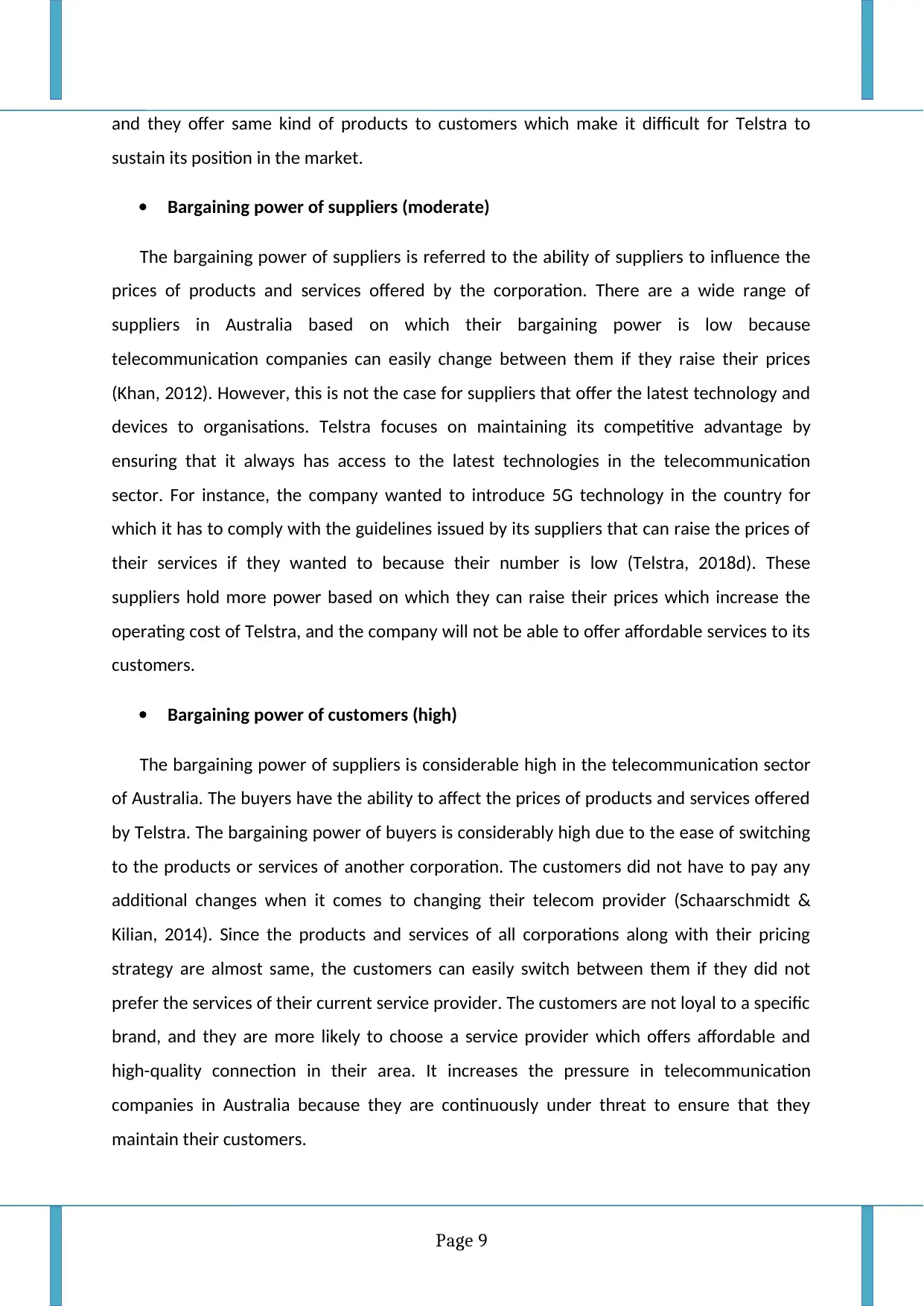
and they offer same kind of products to customers which make it difficult for Telstra to
sustain its position in the market.
Bargaining power of suppliers (moderate)
The bargaining power of suppliers is referred to the ability of suppliers to influence the
prices of products and services offered by the corporation. There are a wide range of
suppliers in Australia based on which their bargaining power is low because
telecommunication companies can easily change between them if they raise their prices
(Khan, 2012). However, this is not the case for suppliers that offer the latest technology and
devices to organisations. Telstra focuses on maintaining its competitive advantage by
ensuring that it always has access to the latest technologies in the telecommunication
sector. For instance, the company wanted to introduce 5G technology in the country for
which it has to comply with the guidelines issued by its suppliers that can raise the prices of
their services if they wanted to because their number is low (Telstra, 2018d). These
suppliers hold more power based on which they can raise their prices which increase the
operating cost of Telstra, and the company will not be able to offer affordable services to its
customers.
Bargaining power of customers (high)
The bargaining power of suppliers is considerable high in the telecommunication sector
of Australia. The buyers have the ability to affect the prices of products and services offered
by Telstra. The bargaining power of buyers is considerably high due to the ease of switching
to the products or services of another corporation. The customers did not have to pay any
additional changes when it comes to changing their telecom provider (Schaarschmidt &
Kilian, 2014). Since the products and services of all corporations along with their pricing
strategy are almost same, the customers can easily switch between them if they did not
prefer the services of their current service provider. The customers are not loyal to a specific
brand, and they are more likely to choose a service provider which offers affordable and
high-quality connection in their area. It increases the pressure in telecommunication
companies in Australia because they are continuously under threat to ensure that they
maintain their customers.
Page 9
sustain its position in the market.
Bargaining power of suppliers (moderate)
The bargaining power of suppliers is referred to the ability of suppliers to influence the
prices of products and services offered by the corporation. There are a wide range of
suppliers in Australia based on which their bargaining power is low because
telecommunication companies can easily change between them if they raise their prices
(Khan, 2012). However, this is not the case for suppliers that offer the latest technology and
devices to organisations. Telstra focuses on maintaining its competitive advantage by
ensuring that it always has access to the latest technologies in the telecommunication
sector. For instance, the company wanted to introduce 5G technology in the country for
which it has to comply with the guidelines issued by its suppliers that can raise the prices of
their services if they wanted to because their number is low (Telstra, 2018d). These
suppliers hold more power based on which they can raise their prices which increase the
operating cost of Telstra, and the company will not be able to offer affordable services to its
customers.
Bargaining power of customers (high)
The bargaining power of suppliers is considerable high in the telecommunication sector
of Australia. The buyers have the ability to affect the prices of products and services offered
by Telstra. The bargaining power of buyers is considerably high due to the ease of switching
to the products or services of another corporation. The customers did not have to pay any
additional changes when it comes to changing their telecom provider (Schaarschmidt &
Kilian, 2014). Since the products and services of all corporations along with their pricing
strategy are almost same, the customers can easily switch between them if they did not
prefer the services of their current service provider. The customers are not loyal to a specific
brand, and they are more likely to choose a service provider which offers affordable and
high-quality connection in their area. It increases the pressure in telecommunication
companies in Australia because they are continuously under threat to ensure that they
maintain their customers.
Page 9
Paraphrase This Document
Need a fresh take? Get an instant paraphrase of this document with our AI Paraphraser
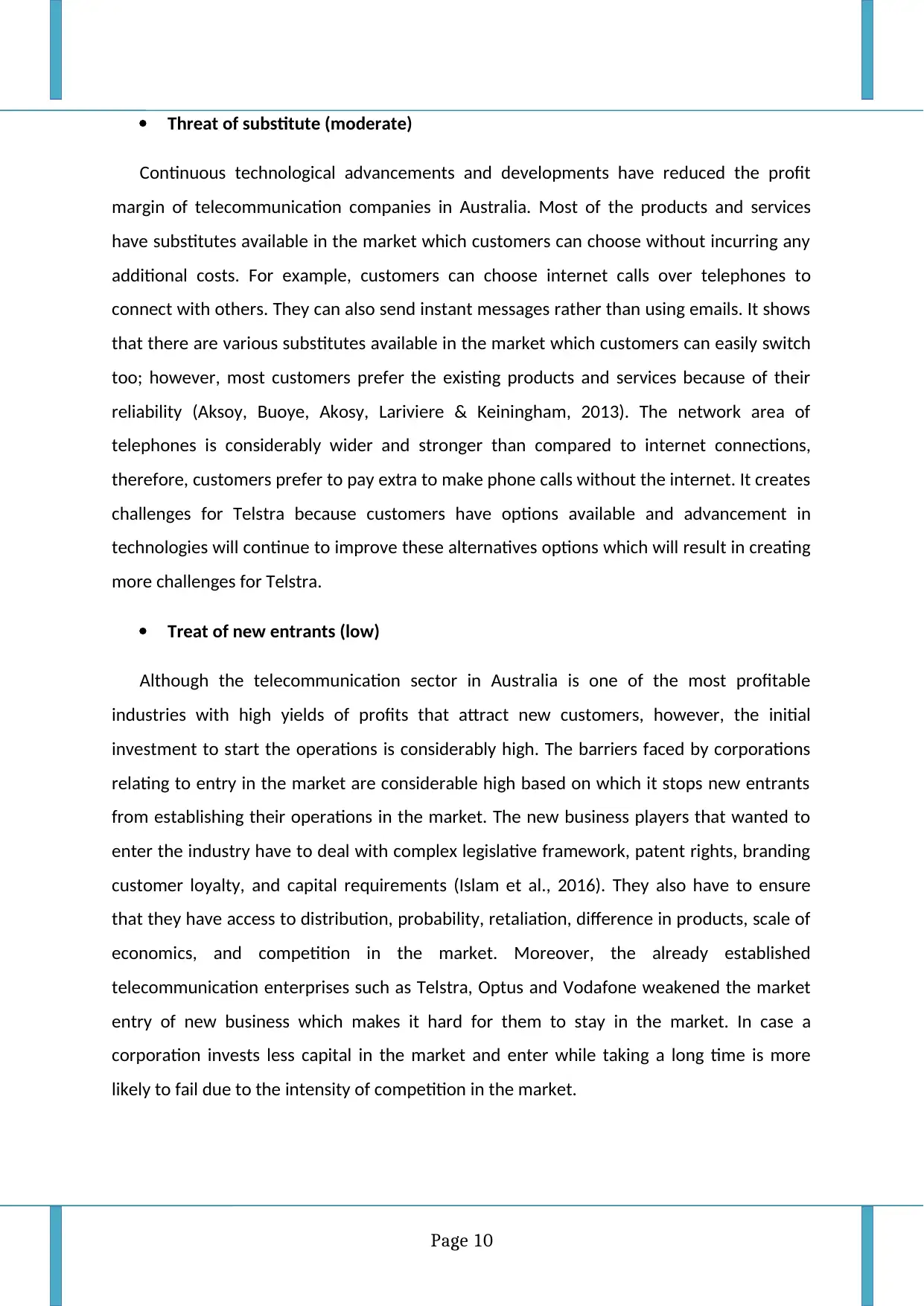
Threat of substitute (moderate)
Continuous technological advancements and developments have reduced the profit
margin of telecommunication companies in Australia. Most of the products and services
have substitutes available in the market which customers can choose without incurring any
additional costs. For example, customers can choose internet calls over telephones to
connect with others. They can also send instant messages rather than using emails. It shows
that there are various substitutes available in the market which customers can easily switch
too; however, most customers prefer the existing products and services because of their
reliability (Aksoy, Buoye, Akosy, Lariviere & Keiningham, 2013). The network area of
telephones is considerably wider and stronger than compared to internet connections,
therefore, customers prefer to pay extra to make phone calls without the internet. It creates
challenges for Telstra because customers have options available and advancement in
technologies will continue to improve these alternatives options which will result in creating
more challenges for Telstra.
Treat of new entrants (low)
Although the telecommunication sector in Australia is one of the most profitable
industries with high yields of profits that attract new customers, however, the initial
investment to start the operations is considerably high. The barriers faced by corporations
relating to entry in the market are considerable high based on which it stops new entrants
from establishing their operations in the market. The new business players that wanted to
enter the industry have to deal with complex legislative framework, patent rights, branding
customer loyalty, and capital requirements (Islam et al., 2016). They also have to ensure
that they have access to distribution, probability, retaliation, difference in products, scale of
economics, and competition in the market. Moreover, the already established
telecommunication enterprises such as Telstra, Optus and Vodafone weakened the market
entry of new business which makes it hard for them to stay in the market. In case a
corporation invests less capital in the market and enter while taking a long time is more
likely to fail due to the intensity of competition in the market.
Page 10
Continuous technological advancements and developments have reduced the profit
margin of telecommunication companies in Australia. Most of the products and services
have substitutes available in the market which customers can choose without incurring any
additional costs. For example, customers can choose internet calls over telephones to
connect with others. They can also send instant messages rather than using emails. It shows
that there are various substitutes available in the market which customers can easily switch
too; however, most customers prefer the existing products and services because of their
reliability (Aksoy, Buoye, Akosy, Lariviere & Keiningham, 2013). The network area of
telephones is considerably wider and stronger than compared to internet connections,
therefore, customers prefer to pay extra to make phone calls without the internet. It creates
challenges for Telstra because customers have options available and advancement in
technologies will continue to improve these alternatives options which will result in creating
more challenges for Telstra.
Treat of new entrants (low)
Although the telecommunication sector in Australia is one of the most profitable
industries with high yields of profits that attract new customers, however, the initial
investment to start the operations is considerably high. The barriers faced by corporations
relating to entry in the market are considerable high based on which it stops new entrants
from establishing their operations in the market. The new business players that wanted to
enter the industry have to deal with complex legislative framework, patent rights, branding
customer loyalty, and capital requirements (Islam et al., 2016). They also have to ensure
that they have access to distribution, probability, retaliation, difference in products, scale of
economics, and competition in the market. Moreover, the already established
telecommunication enterprises such as Telstra, Optus and Vodafone weakened the market
entry of new business which makes it hard for them to stay in the market. In case a
corporation invests less capital in the market and enter while taking a long time is more
likely to fail due to the intensity of competition in the market.
Page 10
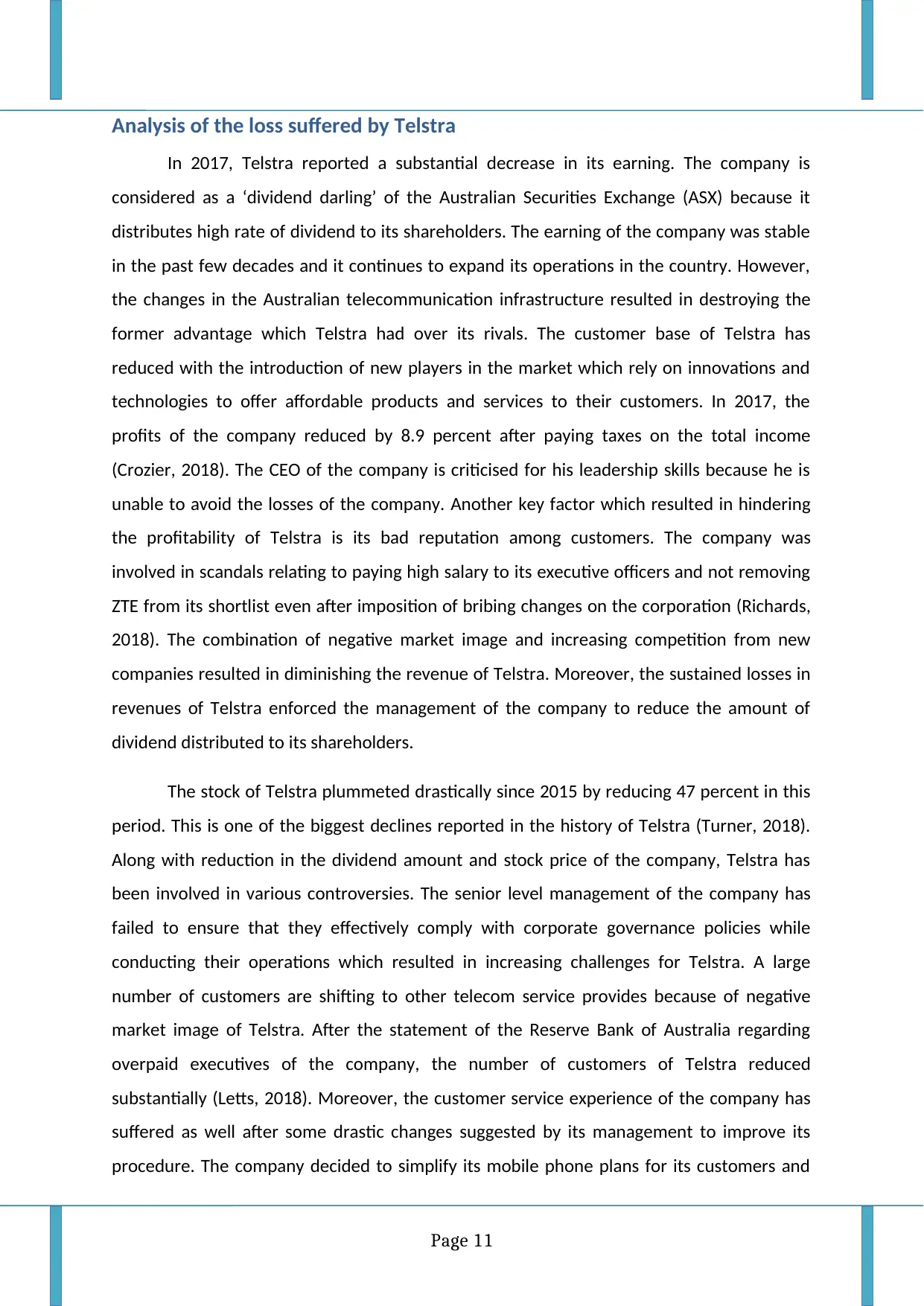
Analysis of the loss suffered by Telstra
In 2017, Telstra reported a substantial decrease in its earning. The company is
considered as a ‘dividend darling’ of the Australian Securities Exchange (ASX) because it
distributes high rate of dividend to its shareholders. The earning of the company was stable
in the past few decades and it continues to expand its operations in the country. However,
the changes in the Australian telecommunication infrastructure resulted in destroying the
former advantage which Telstra had over its rivals. The customer base of Telstra has
reduced with the introduction of new players in the market which rely on innovations and
technologies to offer affordable products and services to their customers. In 2017, the
profits of the company reduced by 8.9 percent after paying taxes on the total income
(Crozier, 2018). The CEO of the company is criticised for his leadership skills because he is
unable to avoid the losses of the company. Another key factor which resulted in hindering
the profitability of Telstra is its bad reputation among customers. The company was
involved in scandals relating to paying high salary to its executive officers and not removing
ZTE from its shortlist even after imposition of bribing changes on the corporation (Richards,
2018). The combination of negative market image and increasing competition from new
companies resulted in diminishing the revenue of Telstra. Moreover, the sustained losses in
revenues of Telstra enforced the management of the company to reduce the amount of
dividend distributed to its shareholders.
The stock of Telstra plummeted drastically since 2015 by reducing 47 percent in this
period. This is one of the biggest declines reported in the history of Telstra (Turner, 2018).
Along with reduction in the dividend amount and stock price of the company, Telstra has
been involved in various controversies. The senior level management of the company has
failed to ensure that they effectively comply with corporate governance policies while
conducting their operations which resulted in increasing challenges for Telstra. A large
number of customers are shifting to other telecom service provides because of negative
market image of Telstra. After the statement of the Reserve Bank of Australia regarding
overpaid executives of the company, the number of customers of Telstra reduced
substantially (Letts, 2018). Moreover, the customer service experience of the company has
suffered as well after some drastic changes suggested by its management to improve its
procedure. The company decided to simplify its mobile phone plans for its customers and
Page 11
In 2017, Telstra reported a substantial decrease in its earning. The company is
considered as a ‘dividend darling’ of the Australian Securities Exchange (ASX) because it
distributes high rate of dividend to its shareholders. The earning of the company was stable
in the past few decades and it continues to expand its operations in the country. However,
the changes in the Australian telecommunication infrastructure resulted in destroying the
former advantage which Telstra had over its rivals. The customer base of Telstra has
reduced with the introduction of new players in the market which rely on innovations and
technologies to offer affordable products and services to their customers. In 2017, the
profits of the company reduced by 8.9 percent after paying taxes on the total income
(Crozier, 2018). The CEO of the company is criticised for his leadership skills because he is
unable to avoid the losses of the company. Another key factor which resulted in hindering
the profitability of Telstra is its bad reputation among customers. The company was
involved in scandals relating to paying high salary to its executive officers and not removing
ZTE from its shortlist even after imposition of bribing changes on the corporation (Richards,
2018). The combination of negative market image and increasing competition from new
companies resulted in diminishing the revenue of Telstra. Moreover, the sustained losses in
revenues of Telstra enforced the management of the company to reduce the amount of
dividend distributed to its shareholders.
The stock of Telstra plummeted drastically since 2015 by reducing 47 percent in this
period. This is one of the biggest declines reported in the history of Telstra (Turner, 2018).
Along with reduction in the dividend amount and stock price of the company, Telstra has
been involved in various controversies. The senior level management of the company has
failed to ensure that they effectively comply with corporate governance policies while
conducting their operations which resulted in increasing challenges for Telstra. A large
number of customers are shifting to other telecom service provides because of negative
market image of Telstra. After the statement of the Reserve Bank of Australia regarding
overpaid executives of the company, the number of customers of Telstra reduced
substantially (Letts, 2018). Moreover, the customer service experience of the company has
suffered as well after some drastic changes suggested by its management to improve its
procedure. The company decided to simplify its mobile phone plans for its customers and
Page 11
⊘ This is a preview!⊘
Do you want full access?
Subscribe today to unlock all pages.

Trusted by 1+ million students worldwide
1 out of 22
Related Documents
Your All-in-One AI-Powered Toolkit for Academic Success.
+13062052269
info@desklib.com
Available 24*7 on WhatsApp / Email
![[object Object]](/_next/static/media/star-bottom.7253800d.svg)
Unlock your academic potential
Copyright © 2020–2025 A2Z Services. All Rights Reserved. Developed and managed by ZUCOL.





